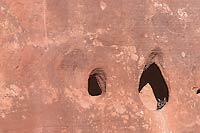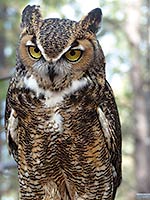Winter can be a magical time in Canyon Country. Low angle light creates long shadows and bathes the canyon walls in rich hues and strong contrasts. Clear night skies ring with crystal-like clarity and expose the beauty of the Milky Way. Though wildlife may seem scarce during this period, there is one creature that announces its presence during these winter nights with deep, resonate “Hoo-hoo’s.”
Great horned owls start the New Year off by calling to mates and letting rivals know they’ve staked out territories. Their classic calls of “Who’s awake? Me, too” punctuate the night’s stillness. Often owls will be heard duetting, establishing the bonds of a mating pair. The male’s deeper pitch is noticeable when the female’s higher-pitched response answers his call.
Named for their large ear tufts, great horneds are an early season breeder, often sitting on eggs in the middle of winter. Relying on a prey base that is active in winter, these massive owls will take anything from small rodents to small mammals such as jackrabbits, cottontails, and even skunks. They’ve also been known to prey upon outside cats, a trait that pet owners should keep in mind before letting their cat outdoors at night. Their nickname “The Flying Tiger” is well deserved.
Adapted to a wide range of habitats, great horned owls may be found in the wild remote canyons of southern Utah, forested woodlands, farmlands, and even suburbia if there is suitable prey nearby. The owls don’t build a nest but often take over an abandoned hawk or raven nest or find a useable tree hollow or abandoned cavity or deep ledge in a canyon wall. 
Though a female owl may lay up to five eggs, generally two or three young will survive the nestling period and fledge. Some juveniles leave the nest at around four or five weeks old, sometimes earlier if they fall out of a nest. For these owlets, they don’t have all their flight feathers yet, but they do have strong talons that allow them to climb into trees. Even if the young leave prematurely, the parent owls will defend the young on the ground and continue to feed it as best they can. This is one reason why it’s good to leave baby owls alone on the ground and not to think they have been abandoned.
It takes about nine or ten weeks for a young owl’s flight feathers to fully develop. However, their ability to fly doesn’t wean them off of parental support; the parents will continue to feed and teach the younger birds to hunt for several months. So, starting this timeline in the middle of winter has a good explanation which is centered around upping the survival rate of the young owls in summer when prey is abundant.
When I worked at Arches as a ranger, I’d often stop near known nest sites along the park road and scope out how the owls were doing. I’m sure many visitors thought I was running radar while parked at the random pullouts. I was more concerned with how these owls of winter were doing rather than who was driving past me.